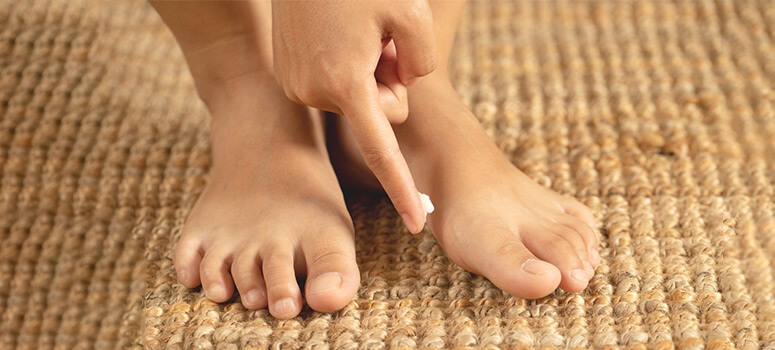Your feet go through a lot more than you can imagine. They are stuffed inside the shoes, go through wear and tear, and carry weight all day long. That puts them at a high risk of injury and infections. It is easy to notice an injury at a glance, but when it comes to infections, they are hard to pinpoint. We often ignore them in the initial phases and notice them when they’ve reached their worst. In this blog, we’ll be discussing the most common fungal infection- Athlete’s Foot and the myths surrounding it.
What is Athlete’s Foot?
Athlete’s Foot got the name as the fungus that causes it is generally found in places where athletes hang out, such as public bathrooms and locker rooms. This skin infection often surfaces when someone comes in contact with the fungus. In this case, the skin between your toes turns white and peels off. It can also affect the soles of your feet and make it difficult for you to walk if the infection becomes severe.
Athlete’s Foot Myths- Busted!
If you or someone you know ever got this infection, we are sure you must have come across weird causes, tips, and treatments that don’t make sense. Believing these myths will only aggravate your condition and delay the healing process. Here we’ll be debunking a few of them and giving you a clear picture of the Athlete’s Foot!
Myth #1
Athlete’s Foot only happens to Athletes.
The most common misconception people have about this skin condition is this one. As explained earlier, Athlete’s Foot is named not because of the people it affects but where the fungus causing it is found. Also, many think it only affects men and not women. This is not the case either. Athlete’s Foot can happen to anyone irrespective of their gender.
Myth #2
Athlete’s Foot and jock itch are different.
The fungus that causes both Athlete’s Foot and Jock Itch is the same called Tinea. This fungus causes a scaly, itchy rash on the feet or near the groin area. Fungal infection caused due to tinea in the feet is called Athlete’s Foot, whereas the one near the groin area is called Jock Itch. These fungal infections are caused mainly due to wearing tight clothing or shoes for a long time and not letting the skin breathe. The sweat helps the fungus to thrive and causes discomfort.
Myth #3
Showering daily can prevent Athlete’s Foot.
This may only sound right, but it isn’t. Showering can be one way of getting infected, especially if you use a public bathroom often. Such places are always damp, serving as a perfect breeding ground for the fungus. Walking barefoot on these floors increases the chances of getting the infection.
Myth #4
Good personal hygiene can lower the risk of an Athlete’s Foot.
Practising good personal hygiene is one way to keep fungal infection risks away. But that doesn’t mean that you’ll not get a fungal infection ever. Wearing tight-fitted shoes, not drying the feet properly after washing them, and walking barefoot on wet floors are the leading causes of this fungal infection.
Myth #5
You can prevent Athlete’s Foot by avoiding walking on a wet floor.
Walking barefoot on a wet floor is one way to get Athlete’s Foot, but it is not the only way. Sharing your shoes, socks, and even towel with someone who already has the infection can be a significant cause too!
Myth #6
Peeling skin is the only symptom of an Athlete’s Foot.
The signs of Athlete’s Foot differ from person to person. So, if it is a rash in your case, it may be skin peeling in another case. Knowing how to identify Athlete’s Foot is important at this point. Take a dermatologist’s help to understand Athlete’s Foot better.
Myth #7
Wearing shoes and socks prevent Athlete’s Foot.
If you think your shoes and socks will protect your feet from Athlete’s Foot, you are wrong. Wearing shoes all day long makes it difficult for your feet to breathe well. The sweat creates a perfect environment for the fungus to develop. Ensuring your feet are completely dry and giving them a “breathing window” will avert the possibility of Athlete’s Foot.
Myth #8
Athlete’s Foot heals on its own.
Wait for a second! Did you believe that? There is no way an Athlete’s Foot can heal on its own. If you neglect the fact that your feet are infected, it will only make it more uncomfortable. The best way is to act on it immediately. Antifungal ointments and oral medication will help Athlete’s Foot heal faster.
Myth #9
Once treated, Athlete’s Foot won’t bother you again.
If you’ve fallen prey to Athlete’s Foot, it can recur again if you don’t take precautions. This skin condition is caused due to external factors. If you walk barefoot on wet floors, do not follow good personal hygiene, or do not dry your feet properly, you’ll likely get infected again.
Myth #10
Home remedies are the best cure for Athlete’s Foot.
Home remedies don’t work on Athlete’s Foot as effectively as antifungal ointments and oral medicines. If you rely on home remedies like vinegar, bleach, tea or antiseptic mouthwash to cure Athlete’s Foot, it is hard to tell if it’ll work. It will only lengthen the healing process and make the infection more miserable.
Heed the dermatologists, not the myths!
Athlete’s foot is a miserable skin condition, but it is treatable. It may cause discomfort, but it is always better to tackle it the right way than to believe in the myths. Now that you’ve read the blog, you must have a clear picture of Athlete’s foot. Furthermore, it is always a good idea to seek a dermatologist’s help as soon as possible and get proper treatment.














